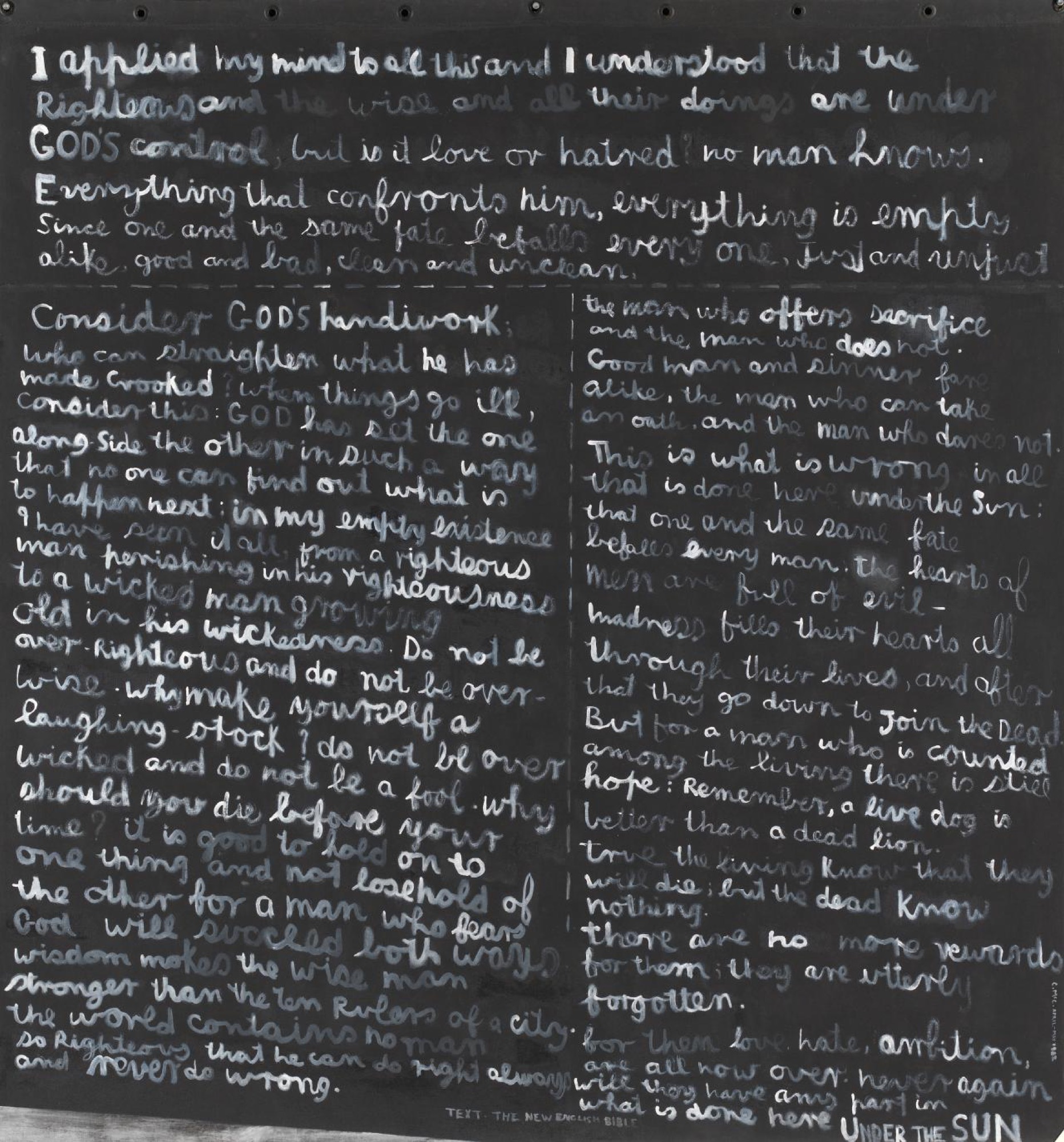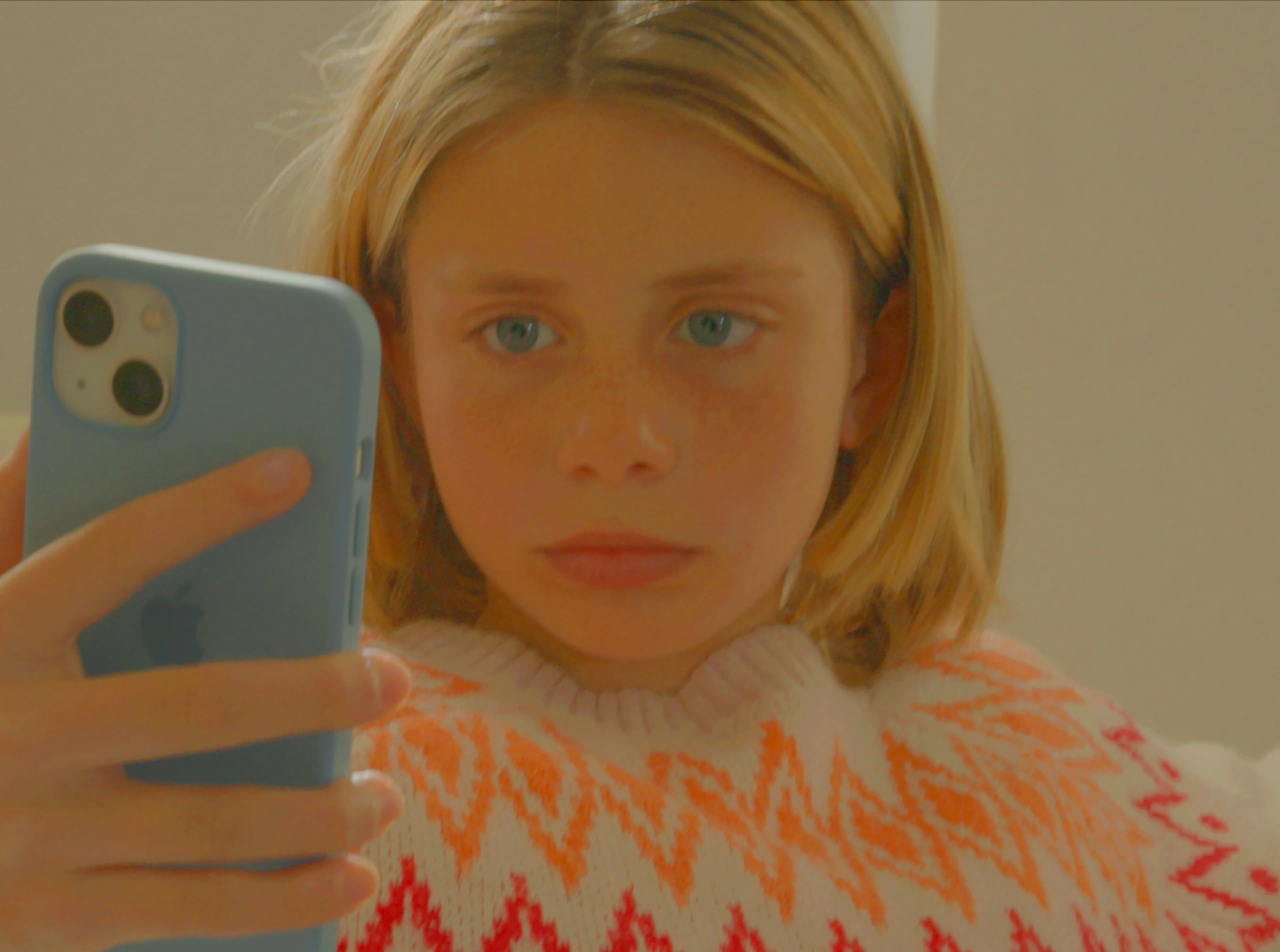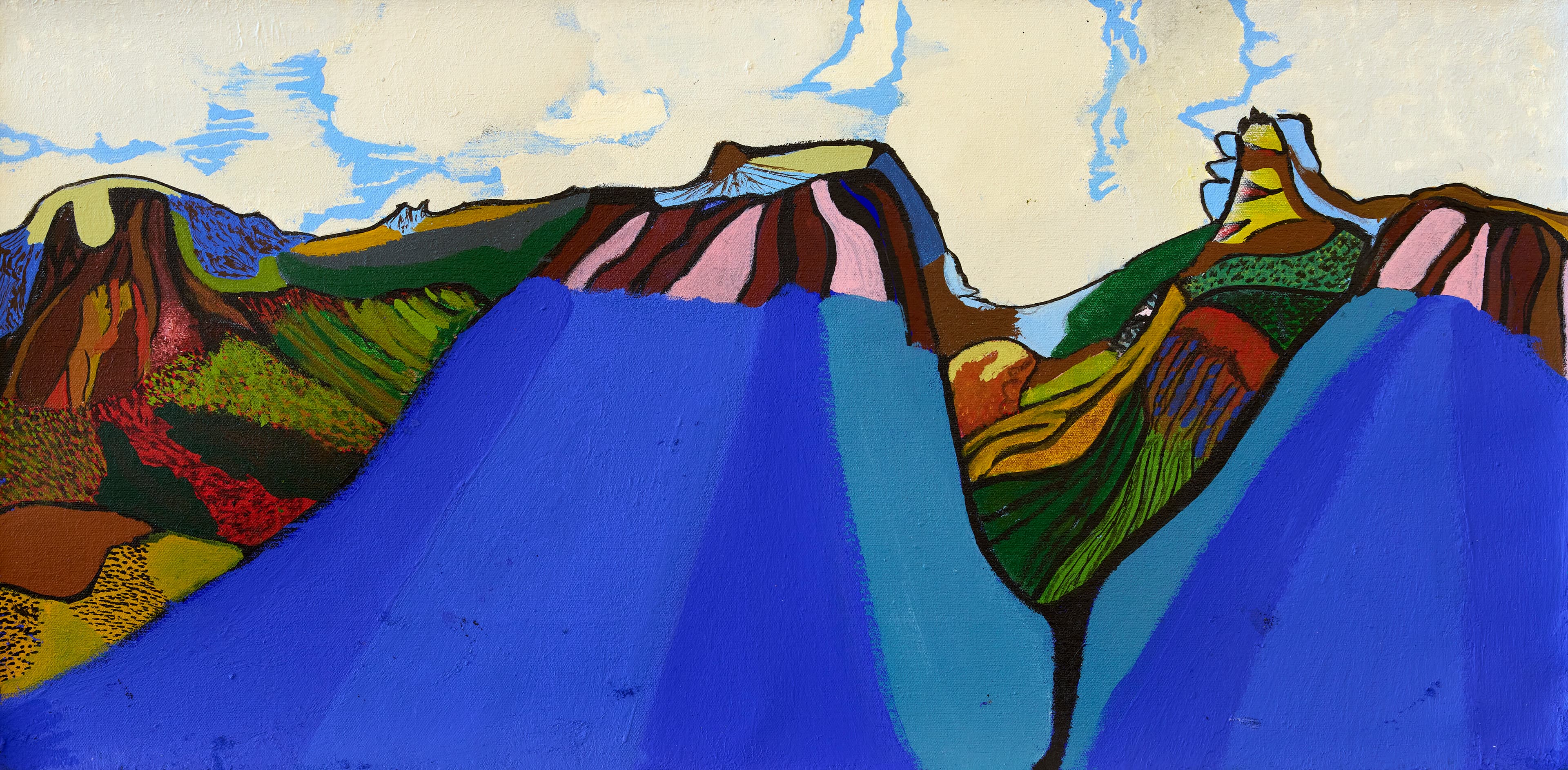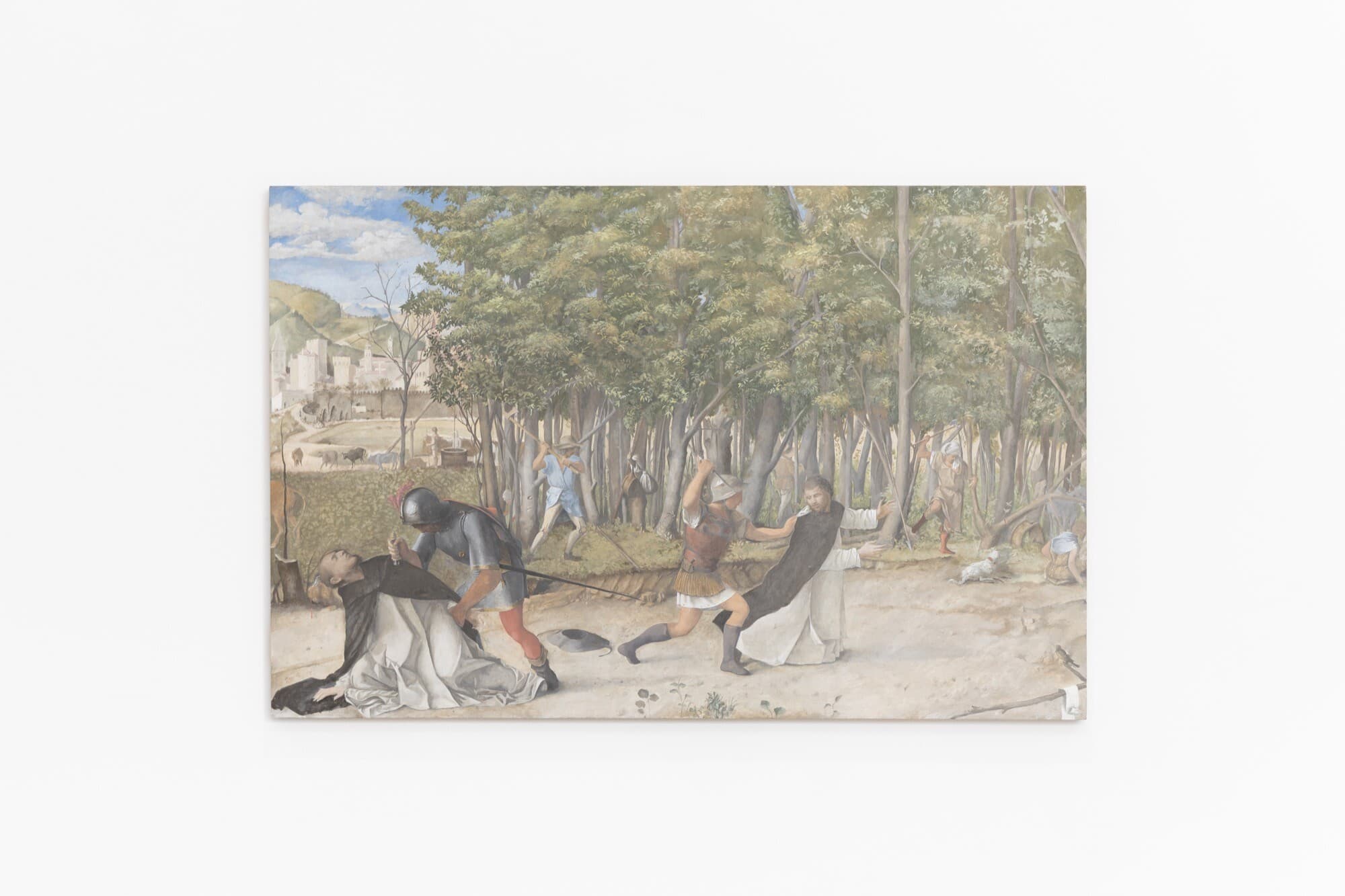Colin McCahon: Letters and Numbers
Luke Smythe
McCahon's centenary began in August, and to mark the occasion curator Jane Devery has mounted Letters and Numbers, a one-room exhibition featuring all six works from the NGV collection and five loans that are promised to the gallery. The show is weighted heavily toward the later years of McCahon's career, which ran from the late 1930s until the early 1980s. The only work to pre-date the 1960s is a facsimile of a book of ink drawings from the early fifties. The drawings have been laid out for inspection in a long vitrine and images of Christ's face feature prominently. Like most of McCahon's early religious works, they are heavily indebted to Georges Rouault. McCahon's style, however, is a touch more naturalistic. His saviour has creases beneath his eyes and there are hints of the landscape behind him, slight departures from Rouault that signal a key difference in McCahon's approach to religious painting. Unlike Rouault's Christ, who is an icon, and is thus shown in a medieval non-space, McCahon's Christ is a man who walks among us. Other drawings in the sketchbook confirm that he is close to us in other ways as well: they show us that his face resembles ours, that he suffers with us, and shares our need for faith amid adversity.
Those who know McCahon will tell you he identified with Christ, and with other biblical protagonists. The most important paintings in the show trace out some of these relationships as they stood toward the end of his career. By this stage the figures in his works had long since departed, leaving in their wake near vacant landscapes and dense accumulations of scripture. One such landscape is The Five Wounds of Christ No. 1 (1977-8), a work on unstretched canvas that has been given pride of place within the show. It hangs in the middle of the gallery, in full view of the doorways at either end. Partitions in the space mask most of the other paintings from these vantage points, a clever piece of staging by Devery that keeps the work in focus until visitors are well inside the room. By this point they are standing in front of it and will be hard-pressed to resist its appeal.
(image: Ff123605.jpg caption: Colin McCAHON, A letter to Hebrews (Rain in Northland) 1979, synthetic polymer paint on 6 sheets of paper, (a-f) 73.0 x 110.2 cm (image and sheet) (each), Colin McCahon Online Catalogue cm001304, National Gallery of Victoria, Melbourne, Presented through The Art Foundation of Victoria in memory of the Reverend Stan Brown by the Reverend Ian Brown, Fellow, 1984, P6.a-f-1984, © Colin McCahon Research and Publication Trust)
Like many similar works in McCahon's oeuvre, The Five Wounds of Christ No. 1 depicts a monumental tau cross, silhouetted against a nebulous night sky. To either side of its abbreviated crossbar are several abstract motifs that creep in from the edges of the canvas. Whether these illumined streaks and squares are hovering in front of the darkness or bleeding through from a brighter realm beyond is hard to tell. It is clear, however, that five of these six forms are stigmata: despite being heavily abstracted, they can be read as open puncture wounds and slashes. The sixth is a looping trail of dots that could be shorthand for a halo or a crown of thorns. As the wall text for the paintings reminds us, McCahon used dashed and dotted lines in many of his paintings. Typically these signalled leaps of faith and the flight paths of souls. The crown-cum-halo is amenable to these readings also, and is therefore the ideal embodiment of what McCahon was drawn to in abstraction: not purity and withdrawal from mimesis, but rather promiscuity of reference. It is a mark of the effectiveness with which he could exploit this open-endedness that Christ's suffering can still suffuse the painting despite his body being absent.

Atmospherically, the work relays the two chief concerns of McCahon's final years as a painter: his sense of existential forsakenness, and his doubts concerning God's benevolence in the light of pervasive sin and suffering. Two later worksin the exhibition serve to highlight these preoccupations. In A Letter to Hebrews (Rain in Northland) (1979), lengthy biblical inscriptions are layered over rudimentary landscapes. They recount the travels and travails of Christ's Hebrew forebears, whose faith in God's direction endured throughout their search for a homeland. Beneath and behind these inscriptions are schematic evocations of the land and sky. The former has been rendered as a wavering black slab, with occasional notches carved out of it. The latter is filled with washed-out cloud formations and slanted sheets of rain, interrupted by muted shafts of sunlight. The hovering black rectangles that appear here and there amid the text are harder to interpret. They suggest editorial redactions, but since no words have been cut from the inscriptions, they are more likely to be gates, of the kind that McCahon had introduced to his painting in the 1960s. He intended these cryptic quadrilaterals to read as obstacles, blocking access to a state of salvation. For him, it was a question of faith as to whether they could ever be negotiated and the promised land attained.
There is no longer any trace of the landscape in I applied my mind (1982), one of the artist's three final paintings. Like the other two, it has the look of a crowded blackboard, replete with erasures and reinscriptions. The citations that fill its compositional compartments also speak of faith. But whereas the inscriptions in A Letter to Hebrews voiced confidence that faith would be rewarded in the aftermath of hardship, this work gives us no such assurances. Instead, McCahon reminds us of his despair in the face of God's indifference to injustice:
Just and unjust alike, good and bad, clean and unclean… This is what is wrong here in all that is done under the sun: that one and the same fate befalls every man.
Of the remaining works on show several more are text-based, while the final four, belonging to a single series, are wordless landscapes. I am drawn to the inscription on one of the three text works, which cites the words of the poet Peter Hooper: 'Poetry isn't in my words,' McCahon has scrawled on brown paper, 'it's in the direction I'm pointing.' This is as good a way as any to describe the deferral of art's meanings, though not all of McCahon's own enigmas are as capable of holding my interests. His number paintings, for example, have never been among my favourites. There is a noted example here, which combines the word 'one' with the letter 'I'. 'I' can also be a number, of course, and 'one' has several meanings, so I understand the puns that are at work here. To my mind, however, the insights they provide are limited.

Compositionally, the four works that complete the show are more to my liking. They are taken from a group of fourteen paintings known as Beach Walk (Series A) (1973), a number chosen to recall the Stations of the Cross. Each consists of ragged colour bands corresponding loosely to the sea, earth and sky. When hung in sequence, they effectively evoke a walk along the foreshore. They are, however, smaller and less immersive than other works of this kind by McCahon, which ultimately makes them less effective. They are restful works, however, and are not without their meditative charms.
(image: Ff105270.jpg caption: Colin McCAHON, Poetry isn’t in my words… 1969, from the Written paintings and drawings series, blue pastel and pastel wash on brown paper, 157.4 x 55.3 cm irreg. (image and sheet), Colin McCahon Online Catalogue cm001489, National Gallery of Victoria, Melbourne, Gift of the Reverend Ian Brown in memory of Annie Christina Brown, 2009, 2009.161, © Colin McCahon Research and Publication Trust)
Kudos to Jane Devery for making Letters and Numbers an example of a smartly-curated collection show. Its checklist was a given, so her key task was to hang the works intelligently, a task that she has carried out judiciously. By making good use of the free-standing partitions at either end of the space, she has been able to create distinct viewing zones within a single room. Where the partitions are present, they cut the width of the room in half, moving viewers closer to the works that she has hung in these areas. All of them are word-based and require proximity to be legible, so this positioning makes sense. So too does the hanging of the The Five Wounds of Christ No. 1 in the middle of the gallery, which at this point is free of partitioning and is therefore twice as wide. It is the show's largest work and the one that can command the biggest viewing distance. It is consequently right where it should be and is the fulcrum around which the room turns.
(image: Ff105271.jpg caption: Colin McCAHON, O Lord I will be mindful of thy justice done 1969, from the Written paintings and drawings series, pastel wash and oil pastel on brown paper, 156.5 x 55.4 cm (image and sheet), Colin McCahon Online Catalogue cm001488, National Gallery of Victoria, Melbourne, Gift of the Reverend Ian Brown in memory of Annie Christina Brown, 2009, 2009.160, © Colin McCahon Research and Publication Trust)
Since the show is on the third floor, it may not receive many visitors. I did notice, however, that several young attendees of the Kaws exhibition (identifiable by their t-shirts and bags of merchandise) had made the long trek up from the lobby. A couple of them drifted in and out, but the third one lingered. McCahon's future will depend on such encounters, so I've chosen to believe that they are frequent and are replenishing the fanbase.
On February 15th, Monash University will be holding 'McCahon 100' at the National Gallery of Victoria, a symposium in honour of McCahon’s centenary that will consider his work’s significance today. Further details to be announced in January.
Luke Smythe is a lecturer in art history and theory at Monash University._ His book Gretchen Albrecht: Between Gesture and Geometry _was published this year by Massey University Press. A book on Gerhard Richter is forthcoming.


